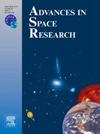Impact of rubber membrane on lunar regolith mechanical properties under low effective confining pressure
IF 2.8
3区 地球科学
Q2 ASTRONOMY & ASTROPHYSICS
引用次数: 0
Abstract
The existing lunar exploration activities and associated equipment interactions are limited to the surface environment, where the stress state of the lunar regolith is significantly lower than that in laboratory tests conducted on Earth. To address this, this paper proposes a new framework for discrete modeling of large-scale triaxial tests on lunar regolith under low confining pressure. The framework incorporates particle shapes from the Chang’E-5 mission (CE-5) and flexible boundary conditions. Firstly, the shape characteristics of the lunar regolith particles were adopted in the Discrete Element Method (DEM) model to reproduce the mechanical properties of the lunar regolith as accurately as possible. Then, experiments with varying membrane particle stiffness ratios were conducted to explore the effect of the rubber membrane’s properties on the mechanical characteristics of lunar regolith under low effective confining pressure. Topological Data Analysis (TDA) tools from persistent homology were utilized to quantify the dynamic response of particles during the onset and development of strain localization. The results indicate that under low effective confining pressure, selecting appropriate rubber membrane types is crucial for accurately determining the mechanical properties of lunar regolith.
求助全文
约1分钟内获得全文
求助全文
来源期刊

Advances in Space Research
地学天文-地球科学综合
CiteScore
5.20
自引率
11.50%
发文量
800
审稿时长
5.8 months
期刊介绍:
The COSPAR publication Advances in Space Research (ASR) is an open journal covering all areas of space research including: space studies of the Earth''s surface, meteorology, climate, the Earth-Moon system, planets and small bodies of the solar system, upper atmospheres, ionospheres and magnetospheres of the Earth and planets including reference atmospheres, space plasmas in the solar system, astrophysics from space, materials sciences in space, fundamental physics in space, space debris, space weather, Earth observations of space phenomena, etc.
NB: Please note that manuscripts related to life sciences as related to space are no more accepted for submission to Advances in Space Research. Such manuscripts should now be submitted to the new COSPAR Journal Life Sciences in Space Research (LSSR).
All submissions are reviewed by two scientists in the field. COSPAR is an interdisciplinary scientific organization concerned with the progress of space research on an international scale. Operating under the rules of ICSU, COSPAR ignores political considerations and considers all questions solely from the scientific viewpoint.
 求助内容:
求助内容: 应助结果提醒方式:
应助结果提醒方式:


